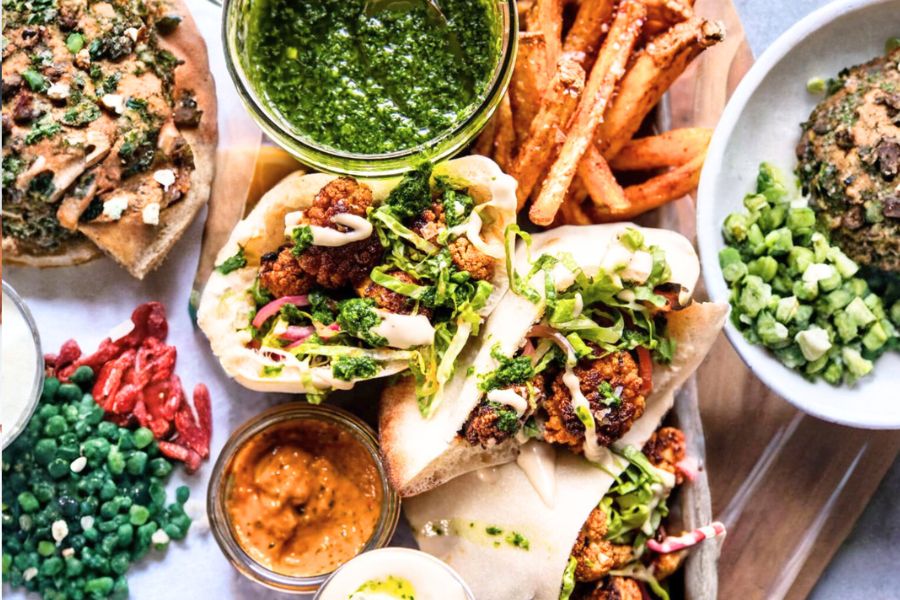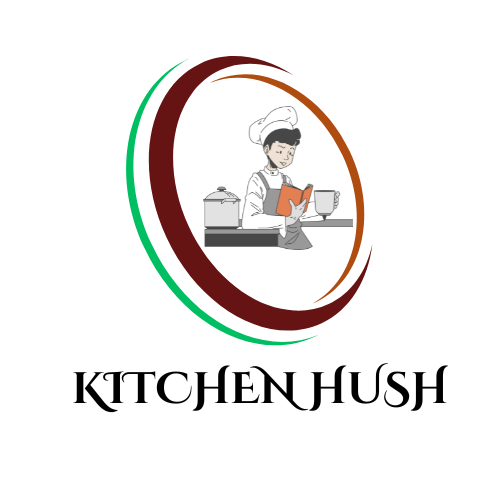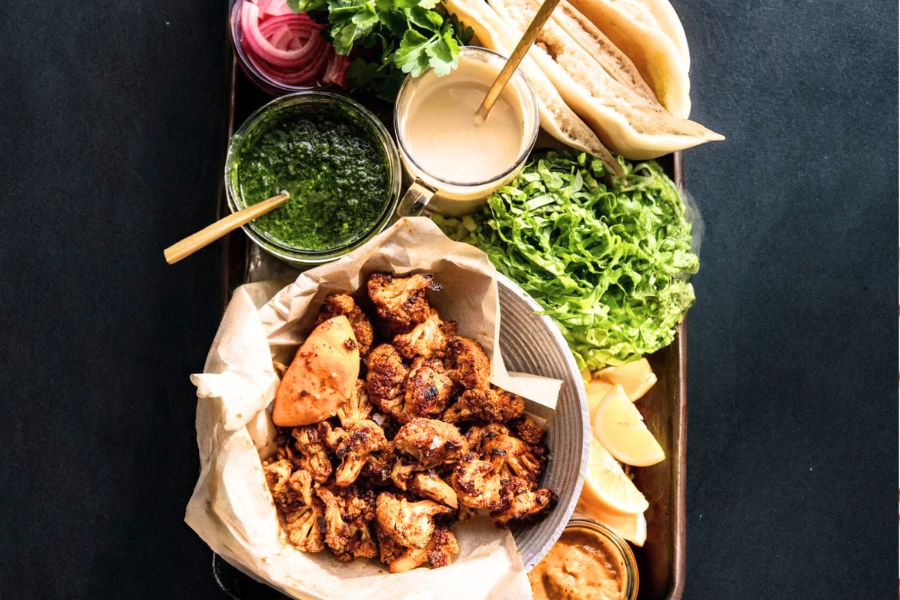This vibrant recipe stands out by transforming humble cauliflower into a flavorful, satisfying main with Middle Eastern-inspired spices and fresh herbs.
Roasting the cauliflower caramelizes it beautifully, boosting flavor while preserving fiber and essential nutrients.
Rich in plant-based fiber and antioxidants, the dish supports digestion and overall health.
The zhug sauce and garlic tahini add heart-healthy fats from olive oil and tahini seeds, making this meal both nourishing and indulgent without relying on animal products.

With warm pitas for comforting carbs, it’s an excellent balanced meal that’s naturally gluten-light if using gluten-free pita.
Quick to prep and bake in under an hour, it’s ideal for weeknight dinners or meal prep.
The bright, herbaceous zhug adds freshness and complexity, making every bite exciting yet wholesome — perfect for anyone looking to enjoy a delicious, plant-forward dinner with minimal fuss.
Must-Have Tools for Perfect Results
Baking Sheet
Essential for roasting the cauliflower evenly and achieving those perfect charred edges that amplify flavor. A sturdy, rimmed baking sheet also makes cleanup easier and can be used for roasting veggies, baking cookies, or sheet-pan dinners.
Food Processor
Crucial for blending the zhug sauce to a fine, vibrant consistency quickly. Beyond this recipe, it’s invaluable for making dips, pestos, nut butters, and chopping ingredients efficiently.
Measuring Spoons
Precision with spices and liquids ensures balanced flavor every time. These are kitchen basics that streamline seasoning and improve recipe consistency.
Mixing Bowl
Perfect for tossing cauliflower with oil and spices, ensuring an even coating. Mixing bowls are versatile essentials used for marinating, mixing batters, and prepping ingredients.
Blender
Used to create smooth sauces like the lemon tahini and mango harissa, blending emulsifies ingredients for silky textures. A blender is a multipurpose tool great for smoothies, soups, and sauces.

Delicious Roasted Cauliflower Pitas
Equipment
- 1 Baking Sheet
- 1 Food Processor
- 1 Measuring spoons (set)
- 1 Mixing Bowl
- 1 Blender
Ingredients
- 1 large cauliflower head broken into florets
- 3 tbsp extra-virgin olive oil
- 1 tbsp smoked or sweet paprika
- 2 tsp ground cumin
- ½ tsp ground cardamom
- ½ tsp ground turmeric
- ¼ to ½ tsp cayenne pepper adjust to taste
- Juice of half a lemon
- 4 garlic cloves minced
- Salt and freshly ground black pepper to taste
- 4 warm naan breads or pita pockets
- Pickled red onions and fresh lettuce for serving
For the Zhug Sauce:
- 1 bunch fresh parsley
- 1 bunch fresh cilantro
- 1 large jalapeño seeded if preferred
- 1 garlic clove finely chopped
- 1 tsp ground cumin
- ½ tsp ground turmeric
- ⅓ cup extra-virgin olive oil
- 2 tbsp fresh lemon juice
Instructions
- Prepare the Cauliflower Florets: Begin by washing the large head of cauliflower under cold running water to remove any dirt or impurities. Pat it dry thoroughly with a clean kitchen towel or paper towels. Cut the cauliflower into evenly sized florets—this helps ensure they roast uniformly. Place the florets in a large mixing bowl, ready for seasoning.
- Season the Cauliflower: Drizzle 3 tablespoons of extra-virgin olive oil over the cauliflower florets. Sprinkle 1 tablespoon smoked or sweet paprika, 2 teaspoons ground cumin, ½ teaspoon ground cardamom, ½ teaspoon ground turmeric, and ¼ to ½ teaspoon cayenne pepper over them. Add the juice from half a fresh lemon for a bright, tangy note. Next, mince 4 garlic cloves finely and add them to the bowl. Finally, season with kosher salt and freshly ground black pepper to taste. Using your hands or a large spoon, toss the florets gently but thoroughly, ensuring each piece is coated evenly with the spice blend and oil.
- Roast the Cauliflower: Preheat your oven to 425°F (220°C). Spread the seasoned cauliflower florets in a single layer on a rimmed baking sheet—avoid overcrowding to ensure they roast rather than steam. Place the baking sheet in the oven and roast for 15 minutes. After this initial roasting time, remove the baking sheet and use a spatula to carefully flip or toss the florets. Return the tray to the oven and continue roasting for an additional 15 minutes. You want the cauliflower to develop a light char with crispy edges while remaining tender inside.
- Make the Zhug Sauce: While the cauliflower roasts, prepare the herby green sauce known as zhug. Gather one bunch each of fresh parsley and cilantro, rinse thoroughly, and roughly chop. Remove seeds from a large jalapeño if you prefer less heat. Add the herbs and jalapeño to a food processor along with one finely chopped garlic clove, 1 teaspoon ground cumin, ½ teaspoon ground turmeric, ⅓ cup extra-virgin olive oil, and 2 tablespoons fresh lemon juice. Pulse the mixture until it becomes finely chopped and well combined. If the sauce is too thick to your liking, add water one tablespoon at a time, pulsing between additions, until you achieve a smooth, sauce-like consistency. Taste and season with salt as needed.
- Warm the Pitas or Naan: Just before the cauliflower finishes roasting, warm your choice of 4 fresh naan breads or pita pockets. This can be done in a dry skillet over medium heat, in a warm oven wrapped in foil, or briefly in the microwave. Warming the bread makes it more pliable and enhances the eating experience.
- Assemble the Pitas: To build your pitas, spread a generous layer of zhug sauce inside each warmed bread. Layer fresh lettuce leaves and a few spoonfuls of the roasted cauliflower florets on top. Add pickled red onions for a tangy crunch. Drizzle more zhug over the fillings for an extra punch of flavor. Optionally, finish with lemon tahini sauce or mango harissa if you like a creamy or spicy kick.
- Serve and Enjoy: Serve the prepared pitas immediately while warm and flavorful. This dish pairs wonderfully with a simple side salad or extra pickled vegetables. Leftovers can be stored in an airtight container and reheated gently for a quick, nutritious meal the next day.
Notes
- Lemon Tahini Sauce: Blend ½ cup tahini with 3 tbsp lemon juice, ½ tsp garlic powder, 1 tsp honey, and ¼ cup water until smooth. Add water to reach desired consistency and season with salt to taste.
- Mango Harissa: Combine ½ cup red harissa paste, 1 cup diced mango, and ¼ cup pickled jalapeños in a blender; blend until smooth for a sweet and spicy kick.
- Adjust cayenne pepper according to your heat preference to keep the dish balanced.
- For a gluten-free option, substitute naan or pita with your favorite gluten-free flatbread.
- Roasting the cauliflower until lightly charred enhances flavor and texture, so don’t skip the toss halfway through cooking.
Chef’s Secrets for Flavor Boost
To truly elevate this roasted cauliflower pita recipe, start by evenly cutting your cauliflower florets into similar sizes to ensure uniform roasting.
Don’t rush the roasting process — the 30-minute cook time with a midway toss is crucial for developing those irresistible charred edges that add smoky depth and texture.
When preparing the zhug sauce, taste as you go, adjusting the lemon juice and spice levels to your preference.
Using fresh herbs like parsley and cilantro is key; if you can’t find both, focus on fresh cilantro for a bright, tangy note.
Also, warming your naan or pita just before assembly keeps them soft and pliable, preventing any cracking or breakage when stuffed.
Lastly, layering the fillings—zhug, lettuce, roasted cauliflower, and pickled onions—creates a perfect balance of textures and flavors that keeps every bite exciting
Serving Suggestions to Impress Guests
These roasted cauliflower pitas make an excellent centerpiece for casual dinners or light lunches.
Serve them alongside a crisp cucumber and tomato salad dressed with lemon and olive oil for a refreshing contrast.
For added protein, consider pairing with a side of chickpea salad or roasted chickpeas spiced with cumin and smoked paprika.
A bowl of warm lentil soup also complements the Middle Eastern flavors beautifully.
For entertaining, offer a spread of toppings like extra zhug, lemon tahini, and mango harissa so guests can customize their pitas.
Light, vibrant, and packed with flavor, these pitas are versatile enough to work as a satisfying vegetarian main or part of a mezze-style meal.
Storage Tips for Freshness and Flavor
If you have leftovers, store the roasted cauliflower separately from the bread to prevent sogginess.
Place the cooled cauliflower florets in an airtight container in the refrigerator for up to 3 days.
The zhug sauce also keeps well in a sealed jar for about a week and can be stirred before serving.
Warm the naan or pita breads briefly in a toaster oven or skillet just before eating to restore softness.
For longer storage, you can freeze the roasted cauliflower in a freezer-safe container for up to 2 months; thaw in the fridge overnight and reheat gently. Avoid assembling the pitas ahead of time to maintain the best texture and flavor upon serving.
Frequently Asked Questions Explained Clearly
Q1: Can I use other vegetables instead of cauliflower?
Absolutely! Broccoli, Brussels sprouts, or even eggplant can be roasted with similar spices for a different yet delicious twist. Just adjust cooking times based on the vegetable’s density.
Q2: Is the recipe gluten-free?
The recipe is naturally gluten-free if you swap naan or pita for gluten-free flatbreads or wraps. Always check labels to ensure gluten-free certification.
Q3: How spicy is the zhug sauce?
Zhug can be adjusted easily—removing jalapeño seeds reduces heat, and you can add more or less cayenne pepper to taste. It delivers a fresh, herbaceous heat rather than overwhelming spice.
Q4: Can I prepare this recipe ahead of time?
You can prep the cauliflower and zhug sauce up to a day in advance, storing them separately in the fridge. Assemble the pitas just before serving for the best texture.
Q5: What can I substitute for tahini in the lemon tahini sauce?
If tahini isn’t available, creamy nut butters like cashew or almond butter can work in a pinch, but the flavor will be richer and less traditional.
This recipe has been adapted and simplified from the original version by halfbakedharvest. We’ve refined the steps for a smoother cooking experience and added helpful notes, nutrition insights, and essential kitchen tools to make it even easier for home cooks.

